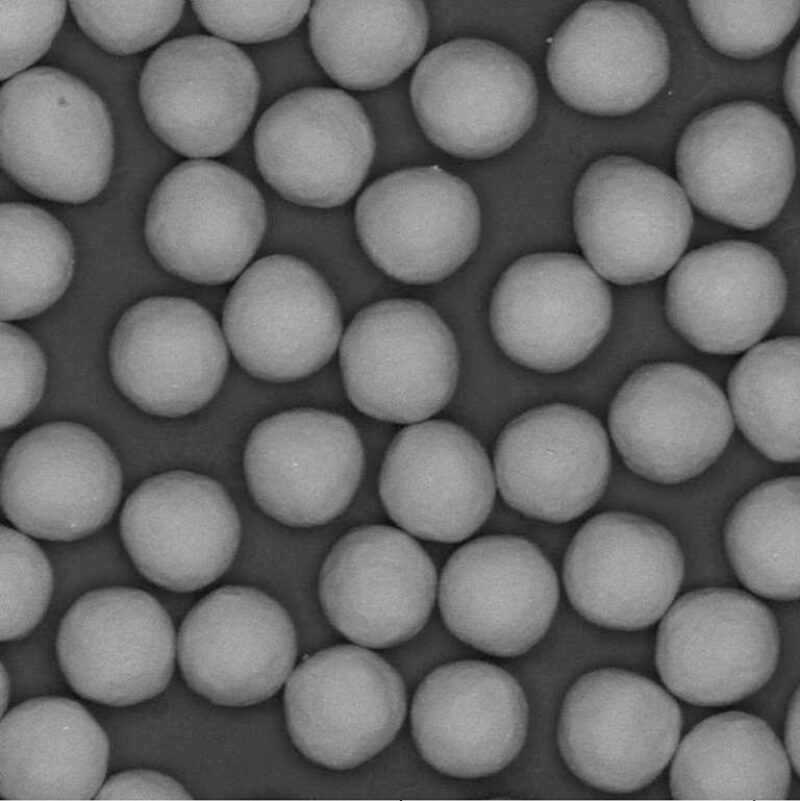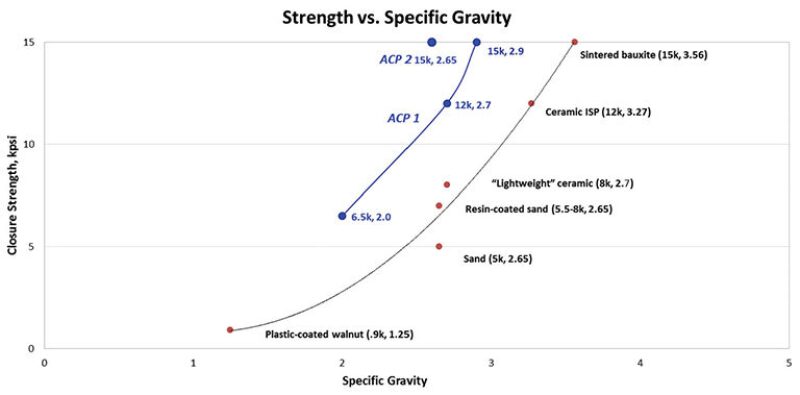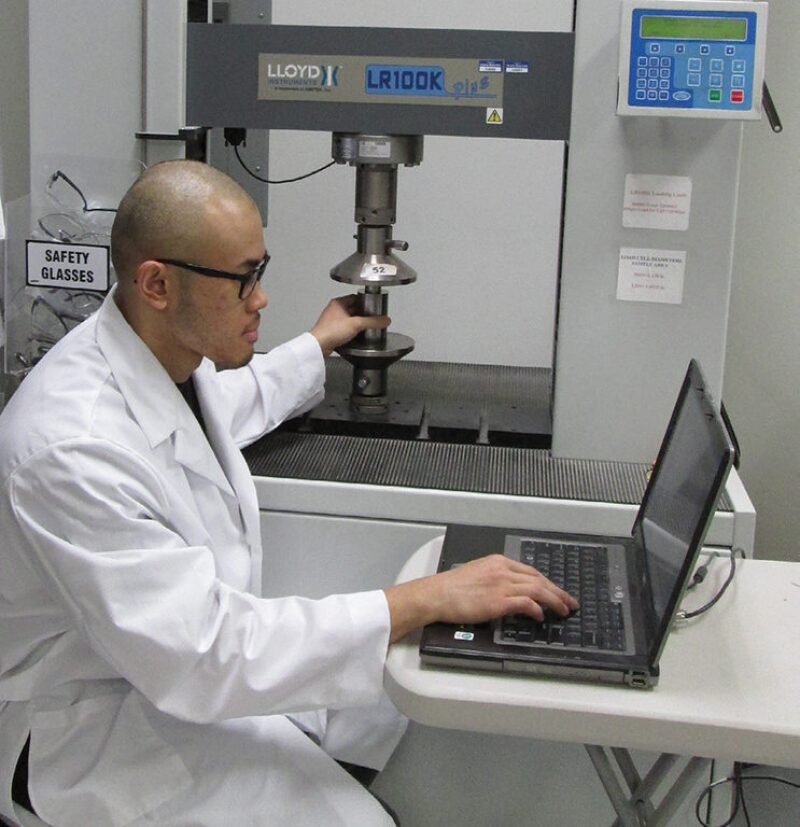At Oxane Materials’ headquarters, signs tell workers to “challenge your assumptions.”
Now the company is out to challenge some of the industry’s assumptions about how much proppant can increase production after fracturing, as part of its campaign to commercialize “advanced ceramic proppant,” which gained notice as the industry’s first proppant created using nanotechnology.
As part of the process, Oxane has changed its slogan from “energy-focused nano-products” to “More oil, more gas, more quickly.”
“People are not buying it because it is nanotech; they are buying it because it works,” said Chris Coker, founder and chief executive officer of Oxane.
After a decade of quiet research and development, building up a library of more than 20 patents, Oxane has begun talking and presenting technical papers. Its first paper describing field testing with the proppant will be delivered at SPE’s Annual Technical Conference and Exhibition in New Orleans.

The company faces a common challenge for innovative new products: It is difficult to persuade decision makers to pay more for a product based on the promise of greater production until there is a body of evidence that supports it. That is not easy given that results in unconventional formations are often uncertain because of hard-to-predict variations in a reservoir.
Oxane says its proppant is stronger pound-for-pound, and is rounder, smoother, more consistently sized, and even bounces farther than others. That last attribute is Oxane’s addition to reasons why some proppant works better than others. Oxane began studying the impact of that property, which it scientifically describes as the “coefficient of restitution,” after a researcher spilled some Oxane proppant and observed how it scattered more than other ceramics or sand.

The thinking is that this contributes to the ability of a proppant to travel farther in larger quantities, allowing the creation of more uniform proppant layers that lead to smoother, higher flows of oil and gas.
The company says it measured the coefficients of variation, friction, and restitution of its proppant and other proppants and compared the levels of saltation. It believes that smooth, uniform-sized balls are less likely to form a stable dune in a fracture, and its “tendency to bounce causes settling particles to re-suspend more easily and be carried farther,” according to the paper that will be presented at the SPE conference.
The comparison can be imagined as dumping a box of golf balls—the uniform, round, bouncy balls are not apt to form a stable mound—versus a box of potatoes—apt to form a stable pile. Oxane’s studies assume the water does not contain chemicals used to keep particles in suspension by increasing viscosity.
The manufacturing method used by Oxane, which puts a hard shell on a spherical core that it manufactures, can produce uniform-sized and shaped proppant. “It improves proppant transport because large particles tend to block smaller ones from moving,” said Mark Mack, vice president of engineering for Oxane. “You could think of this as the large particles tripping up small particles that try to move or sheltering them from the force of the fluid flow.”
How It Works
The direct argument offered in the paper is a 20-well test in west Texas, where Oxane said its proppant resulted in an average 20% production increase over comparable strength, high-quality ceramic proppant after statistical adjustments (see accompanying story). The paper lists several reasons why its advanced ceramic should perform better. The thinking builds on the work of pioneers in ceramic proppant—particularly Terry Palisch, director of petroleum engineering at Carbo, who offered an explanation for why ceramic proppant should outperform sand.
These explanations range from the easy to understand—the properties of ceramics can be engineered to stand up to heavier weights that would crush weaker grains—to concepts such as the impact of non-Darcy flows—tiny differences in proppants can have an outsized impact on the ability of oil and gas to flow through tight, twisting passages that widen and narrow.
“To the extent a proppant is stronger, more uniformly sized, smoother, and lighter, all those things are beneficial,” Palisch said. “The difficult part is quantifying how much benefit those will give in the field, and balancing that with the increased cost.”
Cost Competition
Oxane is trying to grab a small slice of a market now crowded with competitors who jumped in when proppant was in short supply approximately 3 years ago. Since then, the number of companies making ceramic proppant has surged from a handful to more than 70, Palisch said. With additional supplies of proppant now available, companies such as Oxane and Carbo are working to distinguish themselves from lower-cost commodity producers by offering new products.

Carbo has introduced a proppant that releases chemicals to enhance production—an early one controls scale buildup—and said it is working on an ultra-strong proppant that can withstand 20,000 psi, and a chemically coated one that is slicker for smoother flow.
Proppant providers play up quality differences. While the typical process for making ceramic proppant is no secret—mineral-rich clay (ore) is shaped into tiny round bits (pellets) and fired in a kiln (sintering)—some makers say they are far better than others at process control.
“We looked at some proppant supplied in the Bakken for a client,” Palisch said. From the best to the worst ceramic it studied “there can be a 100% difference. You can double your conductivity and flow capacity.”
But purchasing decisions are based on trade-offs between performance and price. “At some point, it is an economic decision,” Palisch said. “We can make diamonds round but no one would buy them because it would cost so much.”
Money Talks
Laboratory analysis is expected with new products, but even when a product has been on the market for some time, it is easy for buyers to second-guess what proppant does in the ground. No one can observe where proppant goes after it leaves the well or what it does when it stops moving. Also, production from wells in unconventional formations varies widely. For example, in the well test reported by Oxane, one well pair produced three times more than another pair.

In the field, an operator nearby getting similar production with cheaper proppant raises questions.
“Everyone looks at what everyone else is doing,” Palisch said. “In the end, you are being pressed for costs that are never going away. You are constantly being asked why you are using that when your neighbor is not.”
That points to the fact that makers of a new product have to appeal to a range of decision makers, including those in management and operations whose focus is likely on bottom-line gains and operational concerns and not just technical measures of proppant performance, said Seeta Resources President Pradeep Anand, a business consultant who teaches a course on marketing in the energy industry at Rice University. Ultimately, engineering studies carry less weight than evidence something can increase profits, he said.
One financial measure of the potential of Oxane’s proppant is the USD 160 million invested to date by a list of companies, including the investment arms of Chevron, BP, ConocoPhillips, and Total. Mack said an encouraging indicator for Oxane has been sales outside its core investor group.
While much of what has been written about Oxane has played up the material used to coat it—Coker said the ingredients include fly ash, which is left after coal is burned in power plants and mixed with metal oxides—its production method is also a departure from the norm.
“For any given strength, we are lighter. For any given weight, we are stronger,” Coker said. “We are working all the time to get stronger and lighter.”
Oxane’s strongest proppant, known as OxSteel, can stand up to 15,000 psi, and has a specific gravity of about 2.9 compared with 3.6 for high-strength ceramic. Its OxBall intermediate strength proppant has a specific gravity of 2.7, which is similar to sand in terms of specific gravity but stronger.
That means Oxane’s proppant will go farther in a stream of water because it is less dense. While a lower specific gravity means Oxane’s proppant is likely to flow farther, strong proppant is far from buoyant in water, with a specific gravity of 1.
A more significant variable is particle size. Larger particles settle faster. Mack said users should change their thinking and use smaller-sized proppant because it will remain suspended longer and is likely to reach the outer area of a fracture network in large enough quantities to provide the structural support needed to stop a fracture from closing.
Oxane’s staff shows a strong commitment to product development, with one-third of its staff in research and development. It is working on improving the materials it uses and its manufacturing methods to create a stronger shell around a core with a more consistent size and shape.
The company’s goal is to be the first to move from the common practice of selling multiple-sized mixes—for example, 40/50 would flow through sieves ranging in size from 40 mesh to 50 mesh—to a process so tightly controlled it can sell a single size, so it would possible to buy proppant that is just 40 mesh.
According to Mack, this would offer several advantages.
- It improves proppant transport because large particles tend to block smaller ones from moving, and can shield them from the force of the fluid.
- Once in place, uniform size enhances conductivity.
While average crush strength is a widely used comparison, Oxane’s technical paper said that more attention should be given to the pressure required to crush the worst performing 10% of its particles. Crushed particles produce fine bits that sharply reduce conductivity. Oxane said its weakest 10% outperform others tested, and when its proppant breaks, it is less likely to produce fines or jagged particles that can have the biggest negative potential on flow.
Ultimately, the point of proppant is to maintain production, as measured by conductivity, through factors such as size, shape, and texture of particles. But when it comes to competitive comparisons, that measure has its drawbacks.
Mack pointed out that a slight change in the device used in the standard lab test for conductivity can change the result by 30 percentage points, depending on who does the test, which is the difference between Oxane’s proppant being a big improvement—with conductivity as much as 40% higher in lab tests—to just marginally better. In the end, Coker said there is no substitute for field results. “What really matters is oil in the tanks at the end,” he said.
OXANE MATERIALS
Background: Created to commercialize materials created and developed at Rice University using nanotechnology.
Total employment: 110
Staff breakdown: Manufacturing 70, R&D 40, Management 10
Investors: Chevron, Energy Ventures, Total, BP, ConocoPhillips, and Carrizo
Total invested: USD 160 million
Fractures pumped: 40 wells
Production capacity:
Current: 1.8 million lb/month
Year-end: 4 million lb/month
Year-end 2014: 9 million lb/month
New Generation Proppant Shows What It Can Do
After more than a decade of development, Oxane Materials is finally talking about what its ceramic proppant can do in the ground. Oxane’s first SPE technical paper reports on a field test in west Texas where it said its “advanced ceramic proppant” improved oil production by an average of 20% in the first 12 months of well production compared with a comparable strength, high-quality ceramic proppant.
The presentation prepared for the 2013 SPE Annual Technical Conference and Exhibition marks a critical step for the company moving from research and development to product commercialization. It is pushing the monthly production capacity of its factory in Arkansas from 1.8 million to 4 million lbm by the end of 2013, and plans to reach to 9 million lbm by the end of 2014.
By the end of August, it made proppant used on 40 fracturing jobs. Oxane is doing another multiwell test and has results from smaller tests on well pads where its proppant was compared with alternatives.

Oxane’s testing program is aimed at convincing operators that paying more for a ceramic proppant covered with a “highly engineered layer of mixed metal oxide” will be rewarded in deeper formations (8,000 ft plus) because of strong, consistently made proppant. The paper concludes that additional production would cover the increased cost of the advanced ceramic proppant in fewer than 5 months.
The paper contends that the Oxane proppant adds about 9% to total well cost, and a production gain of 2.3% would increase the net present value of the well. The study estimates that the 20% cumulative first-year output gain from its advanced ceramic proppant will add 25% to the net present value of the wells in formations where the peak production year represents a sizable share of the ultimate output.
Testing covered 10 well pairs for an unnamed operator and production was reported over the first 12 months. Vertical wells were used to fracture the Wolfcamp shale and adjoining layers. Production was higher where the Oxane proppant was used in five of the well pairs, approximately equal in three pairs, and lower in two.
After 12 months, the paper said the cumulative production edge was 20% over a comparable strength ceramic proppant, after statistical adjustment to eliminate factors other than the proppant difference.
This is on top of the advantage cited by ceramic proppant makers over sand, which previous industry studies have found to be around 20%, Mack said.
The study said that two well pairs, which required the smallest adjustments for factors other than proppant, showed production increases using the Oxane proppant of 19% and 27%, respectively, over the period. Multiple calculations were done to try to eliminate all the differences in the well pairs. The study pointed out production differences caused by well location, pairs where production from one well affected the other, and fracturing jobs where what was pumped in some stages was significantly more or less than what was planned.
Ian Palmer, a petroleum consultant with Higgs-Palmer Technologies, said Oxane’s challenge is that its proppant only yielded higher cumulative production in about half the well pairs, and readers of the technical paper may be resistant to more positive interpretations based on the paper’s complicated regression analysis.
The fractures in the wells ranged in depth from 8,000 ft to 11,000 ft. A mix of sand and ceramic was pumped using slickwater in the middle zones, with progressively more ceramic in the deeper ones, and with only ceramic used in the deepest. Where different types of proppant were used, ceramic was pumped first to see if Oxane’s proppant could add to production by traveling farther, and then last to see if it could provide better conductivity near the wellbore, the paper said.
Overall, ceramic represented about 38% of the proppant used. While the actual amount of proppant pumped per well was in line with the company’s original plan, at times the amount of ceramic proppant used varied by as much as 50% from the plan.
The addition of sand added a level of complexity to the test, Mack said. While the proppant pumped on the well pairs was similar, if the sand was crushed, it blocked flow from the outer reaches of the fractures, where Oxane expected its proppant would further increase production, Mack said.
For Further Reading
SPE 166323 Development and Field Testing of Advanced Ceramic Proppants by Mark G. Mack, Oxane Materials.
SPE 119242 How to Use and Misuse Proppant Crush Tests—Exposing 10 Top Myths by Terry Palisch, Carbo Ceramics.
SPE 164042 Understanding Ceramic Proppants: Are They All Created Equal? by Pedro Saldungaray, Carbo Ceramics.

